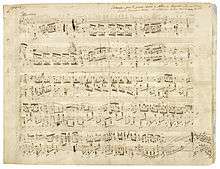Polonaise in A-flat major, Op. 53

Zoom
The Polonaise in A-flat major, Op. 53 (French: Polonaise héroïque, Heroic Polonaise) for solo piano, was written by Frédéric Chopin in 1842.[1] This composition is one of Chopin's most admired compositions and has long been a favorite of the classical piano repertoire. The piece, which is extremely difficult, requires exceptional piano skills and great virtuosity to be interpreted at a high degree of proficiency. It is also very physically demanding, and according to his student Adolphe Gutmann, Chopin played it more gently than most performers. The polonaise was dedicated to Auguste Léo, a German banker and friend of Chopin.[2]
Origin of the Sobriquet 'Heroic'
George Sand, Chopin's longtime lover and companion, responded vigorously to the Revolutions of 1848 as did many intellectuals of the day. When the 1848 Revolution began in France, women had fewer rights than men and Sand believed these were necessary for progress. Around this time, Sand started her own newspaper which was published in a workers' co-operative. This allowed her to publish more political essays, expressing her strongly felt convictions. In one of these, for example, she wrote, "I cannot believe in any republic that starts a revolution by killing its own proletariat." On hearing Chopin's Polonaise in A-flat major, Op. 53, Sand was left with a deep symbolic impression which she communicated to Chopin in their private correspondence. In one of their letters, she wrote passionately, "L'inspiration! La force! La vigueur! Il est indéniable qu'un tel esprit doit être présent dans la Révolution française. Désormais cette polonaise devrait être un symbole, un symbole héroïque!" (Translated: "The inspiration! The force! The vigour! There is no doubt that such a spirit must be present in the French Revolution. From now on this polonaise should be a symbol, a heroic symbol"). In spite of Chopin's reluctance to bestow descriptive names on his music, music scholars and concert pianists have nevertheless associated the grand architecture of the music with this sobriquet, "Heroic."
Technical aspects

The polonaise features many difficult technical aspects, including:
- Fast ascending chromatic perfect fourths
- Rapid, difficult octave scaling
- Trills with the weaker fingers
- Quick scales
- Fast arpeggios
- Broken chords
- Chords with wide fingering
- Use of a wide range of the piano keyboard
Structure
The tempo of the piece is Alla polacca e maestoso ("like a polonaise and majestic"). The form may be viewed as intermediate between ternary (A-B-A) and rondo (A-B-A-C-A), since the first interlude is much shorter than the second (16 vs. 74 bars). The main theme is preceded by an introduction of about thirty seconds in length.
The piece features a grand introduction with fast ascending chromatic notes in both hands, setting the mood of the piece, also; it shows the heroic side of Chopin's art. The first theme is a dance-like theme and in the tonic key of A-flat major. It is the familiar part of the piece and has the left hand moving in pounding octaves. The theme is repeated up an octave with short trills that fill some of the auditory gaps in the theme. The first interlude presents a series of chord progressions that lead into a recount of the traditional polonaise melody, with the polonaise rhythm employed in the left-hand accompaniment. The main theme then repeats once more. The second, main interlude (or trio section) opens with six loud arpeggio chords before switching to a very soft bass ostinato of descending octaves first in the key of E major and then in E-flat major (written as D-sharp major). A march-like melody follows the descending octaves and this occurs twice, and then a long lyrical interlude firstly with harmonic chord progressions and frequent modulations. This ends in a descending passage before the main theme is replayed. The theme is played louder and more dramatically and ends in a coda including material derived from the main theme. A typical performance of the polonaise lasts seven minutes.[1]
 |
Polonaise No.6 in A-flat Major, Op. 53
Performed by Kristian Cvetkovic |
| Problems playing this file? See media help. | |
The piece is written in a 3/4 time marking but includes many implicit deviations from it.
 |
|
| Problems playing this file? See media help. | |
In Popular Culture
The 1945 song "Till the End of Time" by Buddy Kaye and Bud Mossman is based on the Polonaise's main section.
The song "Oliver Cromwell" by Monty Python is sung to the first ("A") section of the Heroic Polonaise.
The song "Hyacinth House" by The Doors musically quotes the main theme during Ray Manzarek's organ solo.
The 1945 film A Song to Remember, a fictionalization of Chopin's life, features the Polonaise.
References
- 1 2 Cummings, Robert. "Polonaise for piano No. 6 in A flat major ("Héroique"), Op. 53, CT. 155". Allmusic.com. Retrieved 2011-11-22.
- ↑ Jonson, Ashton (1905). A Handbook to Chopin's Works. New York: Doubleday. p. 159. ISBN 9783957388186.
External links
- Polonaise in A-flat major, Op.53: Scores at the International Music Score Library Project (IMSLP)
- Heroic Polonaise sheet music at Musopen
- Heroic Polonaise on YouTube, performed by Vladimir Horowitz (Time's "probably the greatest pianist of the 20th century")
- Chopin - Polonaise As-Dur op 53 "Heroique" on YouTube, performed by Rafał Blechacz (the winner of the 15th International Chopin Piano Competition)
- Chopin Valentina Igoshina Polonaise in A Flat 'Heroique' on YouTube performed by Valentina Igoshina (Great Russian Pianist)
- Manuscript (c.1842)